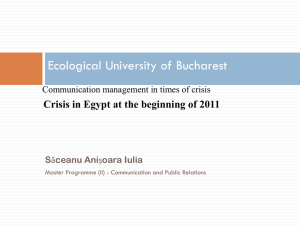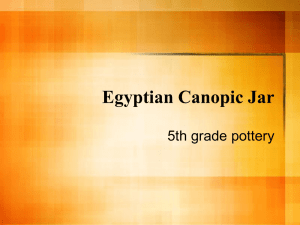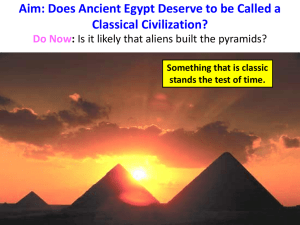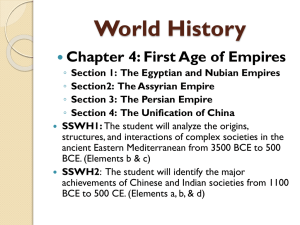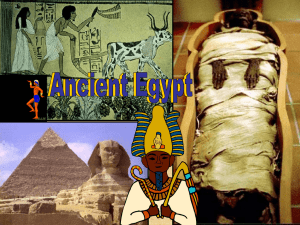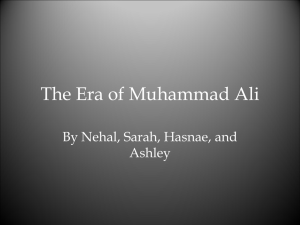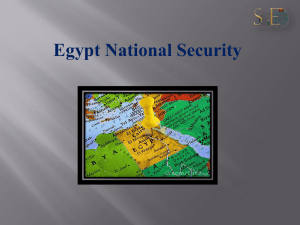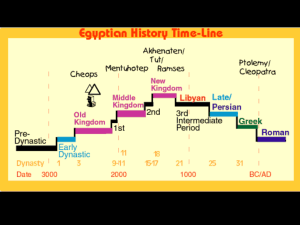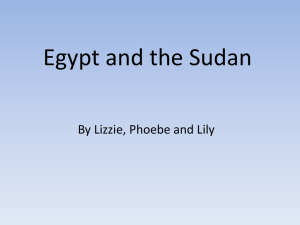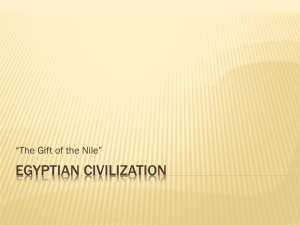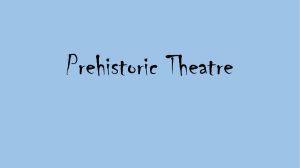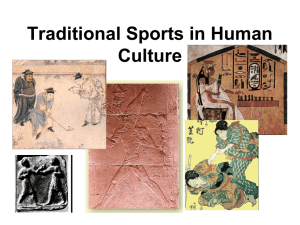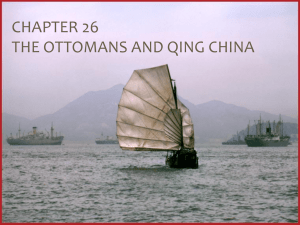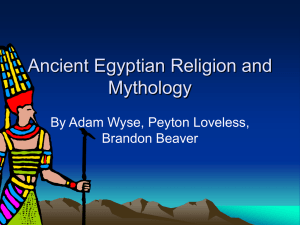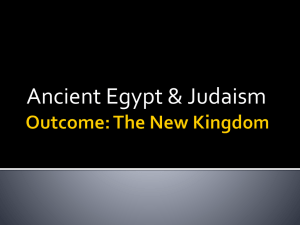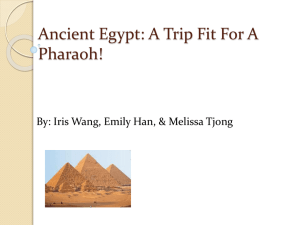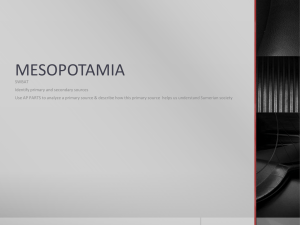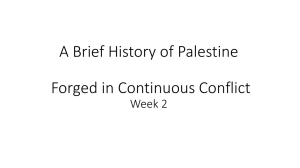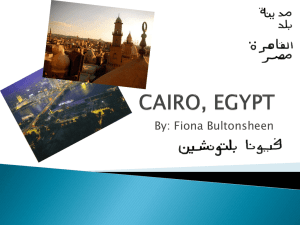Please use the following link to view the picture
advertisement
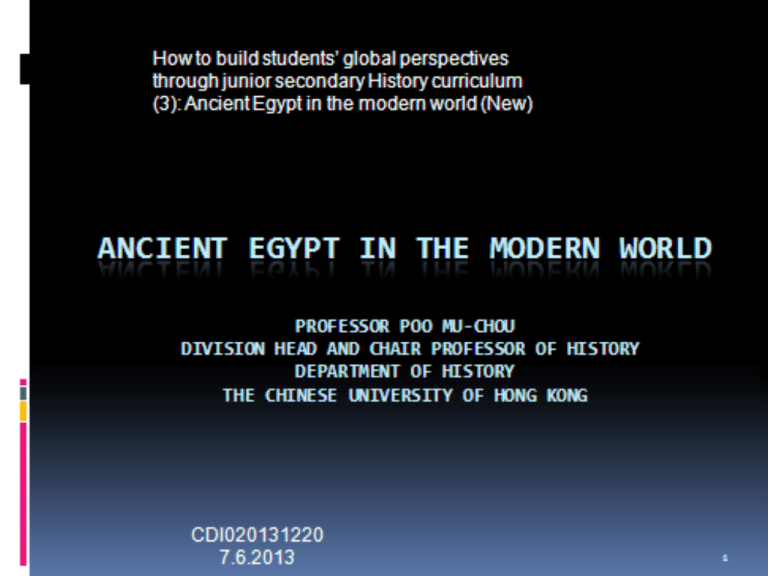
我相信各位老師在教歷史的時候常遇到的問題 之一是,學歷史有什用處。尤其是,古代史有 什麼用處? 雖然這不是什麼新鮮的問題,但的確是重要而 值得不斷思考的問題。我們不能說讀歷史只是 為了聴故事,或者為了找出解決某種問題的答 案,譬如有關政治或社會問題的某些事件的來 龍去脈,以及是非對錯,責任歸屬的問題,尤 其是近現代史,歷史扮演了提供證據的角色, 有它撼衛正義,還原公道的作用。 但是古代史,既然與現實世界的問題以乎 沒有直接關係,有什麼用呢? 1)與近現代史的功能有些類似,找出某 些歷史上事件的真相, 2)在找尋真相的時候,瞭解世界,瞭解 人類社會,瞭解現代世界的形成。 3)給學生一種時間感,一種站在高處回 顧世界的心胸和能力。人的氣質,可以因 為具有歷史的眼光和分析能力而變得更有 深度。 要說明古代史和現代的關係,古埃及可以 是一個例子,但當然不是唯一的例子。 在眾多古文明中,埃及一直占有最受矚目 的排行榜第一,是有它的原因的: 1)古蹟的遺留 2)自古以來的名聲 3)歐洲文明自文藝復興時代以來的推崇 我們今天不談古蹟文物本身,而是要看看 其它兩項因素。 希望今天能夠傳達的要點: 1)現代世界的文化多元性。 2)每一件事物都有它的歷史,都可能有 一段曲折而長遠的故事。 3)不但每一件事物有它的歷史,每一個 我們身邊的現象也都不是偶然,而可能有 其特殊的來源。 4)歷史教育的目標之一,就是告訴學生 這些可能性,以及探索這些可能性的興趣 和能力。 1. THE IMAGE OF EGYPT IN EUROPE THROUGHOUT THE AGES 所有的歷史都是現代史 NAPOLEON IN EGYPT 1799 Please use the following link to view the picture http://i491.photobucket.com/albums/rr280/Fo undingFather1776/Top%205%20Sinister%20L ogos/Pic14napoleon.jpg Napoleon in Egypt 1799 Why Egypt? Institute d’ Égypte (Mathmatics, physics, literature, political economy) Déscription d’ Égypte (1809-1828) Rosetta stone The Rosetta Stone Please use the following link to view picture of The Rosetta Stone http://jdownsrosetta.files.wordpress.com/201 0/04/rosetta-stone-11.jpg Egypt in the Eyes of the Greeks Iliad II, IX, 383-384 Thebes was a rich place, it has a hundred gates, every gate could allow two hundred warriors and their chariots to pass through. Odysseus IV, 220-23;232 Egypt was a far away country, but Helen brought back from there the magical grass which could let people forget sorry and pain. Egyptians are the most knowledgeable doctors in the world. Some Greek terms originated in Egyptian MEMPHIS=Mn-nfr=The beautiful fortress Egypt=Aegyptus= Hut-ka-Ptah=Mansion of the soul of the god Path New Kingdom wall paintings: Minoans from Crete had visited Egypt Please use the following link to view the wall paintings http://www.malerei-meisterwerke.de/images/maler-dergrabkammer-des-mencheperresonb-grabkammer-desmencheperresonb-hohepriester-des-amun-szene-asiatischertributbringer-05844.jpg Greek perceptions of Egypt: the beginning of an ambivalent attitude 1. idealizing 2. scandalizing Herodotus: Egypt was the oldest nation in the world, Egypt possess great wisdom, the Egyptian priest are the wisest and most intelligent people. On the other hand, he noted some strange customs of the Egyptians: The Egyptians have adopted customs and practices which almost invariably are the opposite of those followed by people elsewhere: men weave, women work the land, people eat outside of the house, but defecate inside; in mourning they allow their beards to grow while in Greece the men shave; men carry weights on their heads and women on their shoulders; women urinate standing up while men squat down. Plato (428-347BCE) Egypt is an ideal state, a model, where everything was orderly; music, art and dance are part of the religious ceremonies. In Greek tragedy, Egypt‘s image was not positive, because it was on the Persian side during the Persian Wars. (for example, the Egyptians were thought to be deceptors, the term “to Egyptize” means to deceive.) But on the other hand Egypt was a rich country, its priests were wise people who guided the people. Diodorus Siculus (fl. 1st century BCE)(General History) was other serious writer about Egypt. D. visited Egypt in about 59 B. C., and quoted his personal experience in Egypt, but he also relied upon previous writers such as Herodotus very heavily. He recounts the story that Osiris was a beneficent king resembling Dionysus. Egypt had three classes: the Priest, the soldiers, and the technicians. Their trades were hereditary. The king did everything according to the sacred law, thus what he did was all according to the highest standards. Strabo (63 BCE-24CE), Geographica Lived at Alexandria for some years , and had travelled through Egypt from north to south. In his Geographica his gave a rather detailed and accurate survey of the land of Egypt. Thus his work is still quite useful in the study of ancient geography of Egypt. Plutrach. (A. D. 50-120) In his De Iside et Osiride, (Isis and Osiris), he narrated the famous Egyptian mythological story about the murder of Osiris and the avenge of his son Horus against his murderer and brother Seth. Plutrach gave various explanations to the myth: Osiris was the Nile, Isis the earth, Seth (Typhon) the sea; or, Osiris the moonlight, Seth the sun; or Seth the drought, Horus, who finally avenged his father, was the rain. His explanation can be see as “nature allegory” Roman period Because of the affairs of Caesar and Mark Antony with Cleopatra, Egyptian culture was much known in Rome. The goddess Isis, already an important mother goddess in the Hellenistic period, was once widely worshipped in the Roman world. Antinous, a Roman dressed in Egyptian Style (2nd century CE) Please use the following link to view the picture http://webfea.fea.aub.edu.lb/arch121/Roman %20Art/VII24.jpg Roman wall paintings with Egyptian themes from Herculaneum Please use the following links to view pictures of Roman wall paintings http://www.bbc.co.uk/history/ancient/romans/ images/gal_daily_isis.jpg http://www.scalarchives.com/scalapic/011206/ c/0053865c.jpg A pyramid in Rome (tomb of Cestius Epulo, 12 BCE) Please use the following link to view the picture of pyramid in Rome http://www.alchimiabb.net/ita/images/piramid e_cestia.jpg Recent study shows that quite a number of Graeco Roman papyri recorded cultural interactions between Greek culture and Egyptian culture. These are mainly a variety of Demotic and Greek documents. There are evidence of Greek words borrowed by Egyptian, or vise versa. In literary texts, mutual borrowing and influence are evident. During the Graeco Roman period the intellectuals of Egypt and Greece were in contact, thus the idea that the Greeks and Romans knew little about Egypt was not correct. This is probably caused by the bias of the traditional Classic scholars. Another reason: the Demotic literature of the Graeco-Roman period has not been well understood. Europe from Medieval to Renaissance Christian theology was the major intellectual guide of European intellectuals during the Medieval period. In the Christian tradition, the image of Egypt was mainly a negative one, since in the Bible Egypt was a place where the Israelites suffered. Early Christians in Egypt used to destroy the Egyptian temples and statues for those are the idols of the heathen. The Arabs The Arabs of the Medieval period regarded the ancient architectures were built by giants or magicians. Their main interests were to find treasures. In the 9th century, a person named Ma’mun dug into the great pyramid of Giza, but found nothing. In the tenth century, the casing stone of the Giza pyramids were moved to build the city of Cairo. Medieval Arab scholars were rather interested in ancient Egyptian antiquities. 1200, a doctor named Abd’ el-Latif went to visit the Giza pyramids and found that the Sphinx was intact. He gave a detailed description of it, but since it was written in Arabic, it was unknown to the Europeans until the 19th century. Abu Ja’far Al-Idrisi (d. 1251)was the first Arab scholar who studied the pyramids systematically. He not only analyzed the shape and reason for the building of the pyramid, but also studied the chemical compound of the dirt in the buildings to determine the origin of the buildings. The Arabs also studied Coptic texts, which was of help to the European scholars in the decipherment of the Egyptian script. In sum, the Greeks knew of the ancient history of Egypt, and they idealized Egyptian wisdom, but these were not enough to encourage them to study in depth Egyptian civilization. The Romans regarded Egypt as their granary, yet were not really interested in Egyptian culture. The Arabs had certain interest in Egypt, yet their main stream Arabic culture did not allow them to go further into this culturally and religiously very different ancient civilization. Before the Renaissance, Egypt was not really regarded in the eyes of the Europeans as an important place in history and culture. After the Renaissance Because of the struggle between the Europeans and the Arabs during the late Medieval period, Europeans did not have much contact with Egypt. After the 14th century, because of the effort of Renaissance intelletcuals, classics of the GreacoRoman period were re-discovered, and with this the interest in Egypt. When the Turkish empire began to crumble, the obstacle between East and West travel was gradually removed. Many Europeans began to travel to the East and wrote about their experience in Egypt. Thus Europeans in general began to know more about Egypt. 17th and 18th century There were about 200 travelogues about Egypt from 1400 to 1700, which shows the European interest in Egypt. The development of imperialism als0 increased the interest in Egypt. But the Egyptian language was still seen as a mysterious symbol system, each sign was regarded as having secrete meaning, the entire text was a combination of series of symbolic meanings that contain the secrete of the world and ultimate wisdom. Such understanding no doubt came from the ancient Greek idea that Egypt possessed the supreme wisdom. Athanasius Kircher (1602-1680) was a Jesuite father, wrote many works about Egypt, and studied the Egyptian language. His contribution in this regard are two fold: one, he discovered the importance of Coptic in the study of Egyptian hieroglyphs, two, his study of the Egyptian hieroglyphs was still using the symbolic understanding, thus he did not find the key to decipher the Egyptian writing. 2. The establishment of Egyptology When the Rosetta Stone was found in 1799, the French scholars made rubbings and sent back for study. But after the war, French was defeated by the British, the Rosetta Stone was shipped to London and put in the British Museum. Johan D. Akerblad (1763-1819) first recognized some Demotic alphabets, but because he thought that all demotic signs were monosyllabic, he failed to make further progress. Thomas Young (1773-1824)discovered that Demotic signs and Hieratic signs are evolved from the hieroglyphic signs, thus he knew that Demotic was not a complete alphabetical system. Thus he thought that Egyptian writing was a combination of phonetic signs and ideographic signs. He correctly identified 6 hieroglyphic signs and the corresponding Greek alphabets and thought that the Egyptian writing and Coptic had a close relationship. F. Champollion (1790-1832) Building upon the research of previous scholars, he finally deciphered in 1824 the Egyptian hieroglyphic writing, which was basically phonetic writing with phonetic signs of various syllabus, plus a number of non-phonetic signs or ideographic signs that denote the meaning of the word. He became the first Egyptological professor at the College de France in 1831. Richard Lepsius, Denkmäler aus Ägypten und Äthiopien (Berlin, 1849-50; 1884), 12vols of plates, 7 volumes of documents. First Egyptological Journal: Zietschrift für Aegyptische Sprache und Altertumskunde. Auguste Mariette (1821-1881), first systematic archaeologist, established the Cairo Museum Gaston Maspero (1846-1916), turning the goal of archaeology: from object and treasure collecting to using objects to understand the life of the ancients. Flinders Petrie (1853-1942) founder of modern archaeology In order to understand the ancient society, one has to study the relationship between objects. He established a sequence dating system using pottery shapes to determine the relative chronology between different sites. Archaeology is a science that involves planning, digging, recording, publishing, protecting, and museum display. In 1892, Petrie became the first Egyptological professor at the University of London (the late famous Chinese archaeologist Xia Nai 夏鼐 was his student). 20th Century 現代社會中的古埃及形象 音樂,電影,小說,時尚,建築 Music and opera e.g. Aida Movies e.g. Cleopatra The Mummy Novels e.g. Ramses -The Son of the Light, Christian Jacq Ramses -The Lady of Abu Simbel, Christian Jacq Fashion Obelisks around the world London Vatican Paris Egyptianized art Past Glory, today’s pride?

